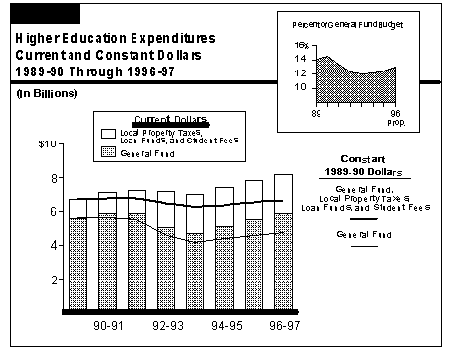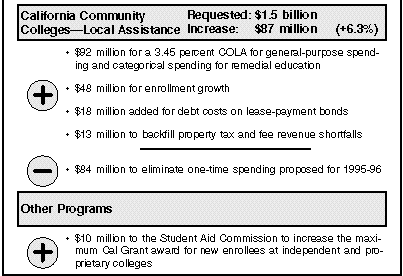

The budget proposes modest increases in state spending for all higher education segments, and no increases in undergraduate student fees.
The budget proposes General Fund expenditures of $5.9 billion for higher education in 1996-97. This is $358 million, or 6.5 percent, more than estimated expenditures in the current year. Including local property tax revenues assumed for community colleges, the budget proposes spending of $7.2 billion, which is $367 million, or 5.4 percent, more than estimated expenditures in the current year.
Figure 1 (see next page) shows that higher education expenditures from the General Fund have increased by $275 million since 1989-90, representing an average annual increase of 0.7 percent. When these expenditures are adjusted for inflation, General Fund spending decreased over this time period by an average of 2.2 percent annually.
The share of General Fund spending allocated to higher education has declined from 14 percent to 13 percent over this period. Including increased student fees (net of financial aid), local property taxes, and loan funds, higher education expenditures have increased by $1.5 billion over the period, an average annual increase of 3 percent. Adjusted for inflation, spending has decreased slightly, by less than 0.5 percent annually.

Figure 2 shows spending from the General Fund, local taxes, and student fee revenues (net of financial aid) in detail.
For the University of California (UC) and the California State University (CSU), the budget proposes General Fund increases of $124.1 million (6.5 percent) and $95.5 million (5.7 percent), respectively. (The CSU figure understates actual budget-year growth, because 1995-96 expenditures include $20 million in one-time spending.)
The budget proposes no undergraduate fee increases for the UC or CSU. Increased fees for UC professional programs and enrollment changes account for the increases in student fee revenues shown in Figure 2. Based on these fee proposals, total revenues would increase by $141 million (5.9 percent) at the UC and by $99 million (4.7 percent) at the CSU.
For the California Community Colleges (CCC), the budget proposes to increase support from the General Fund in 1996-97 by $86.7 million (6.3 percent). Combined support from the General Fund, property tax revenues, and net student fee revenues is proposed to increase by $94.4 million (3.3 percent). (The CCC figure understates actual budget-year growth, because the 1995-96 expenditures include $79 million in one-time expenditures.) The budget proposes to leave CCC fees at their existing level of $13 per credit unit.
| Figure 2 Higher Education Budget Summary Selected Funds Sourcesa 1994-95 Through 1996-97 (Dollars in Millions) |
|||||
|---|---|---|---|---|---|
| Actual 1994-95 | Estimated 1995-96 | Proposed 1996-97 | Change From 1995-96 | ||
| Amount | Percent | ||||
| University of California | |||||
| General Fund | $1,825.4 | $1,917.7 | $2,041.8 | $124.1 | 6.5% |
| 1996 higher education capital outlay bond fund | -- | -- | 10.0 | 10.0 | --b |
| Student fee revenues | 456.6 | 476.3 | 483.3 | 7.0 | 1.5 |
| Totals | $2,282.0 | $2,394.0 | $2,535.1 | $141.1 | 5.9% |
| California State University | |||||
| General Fund | $1,578.1 | $1,673.8 | $1,769.3 | $95.5 | 5.7% |
| Student fee revenues | 341.6 | 343.6 | 347.2 | 3.6 | 1.1 |
| Totals | $1,919.7 | $2,017.4 | $2,116.5 | $99.1 | 4.7% |
| California Community Colleges--local assistance | |||||
| General Fund (Proposition 98) | $1,182.2 | $1,373.2 | $1,459.9 | $86.7 | 6.3% |
| General Fund (non-Proposition 98) | 3.1 | 0.2 | -- | -0.2 | -100.0 |
| Local property taxes | 1,332.0 | 1,348.1 | 1,356.9 | 8.8 | 0.7 |
| Student fee revenues | 174.9 | 164.6 | 163.7 | -0.9 | -0.5 |
| Totals | $2,692.2 | $2,886.1 | $2,980.6 | $94.4 | 3.3% |
| Student Aid Commission --local assistance | |||||
| General Fund | $222.9 | $234.4 | $245.9 | $11.4 | 4.9% |
| a Student fee revenues are net of financial aid. For 1996-97, selected bond funds for UC that are proposed to support deferred maintenance are displayed to allow for comparison with CSU and the community colleges, where deferred maintenance is supported through the General Fund. | |||||
| b Not a meaningful figure. | |||||
Figure 3 presents the major budget changes in General Fund spending for higher education. The budget proposes $270 million for increases in employee compensation and prices ($100 million at UC, $68 million at CSU, and $92 million at the CCCs). An additional $59 million is proposed to increase the level of funded enrollment in the three segments ($9 million at UC, $12 million at CSU, and $48 million at CCCs). Funding for debt service costs on previously authorized lease-payment bonds also accounts for a significant portion of the General Fund increase--$42 million ($13 million at UC, $11 million at CSU, and $18 million at CCCs).
The budget proposes increased deferred maintenance funding for all three segments. However, Figure 3 shows only the proposed General Fund expenditures in 1996-97--$9.6 million for CSU. The budget also proposes to allocate other funds for deferred maintenance, as follows:
Figure 4 (see page 10) shows student enrollment at each of the segments. It shows that the UC's full-time-equivalent (FTE) enrollment will remain essentially steady from 1993-94 through 1995-96. The CSU's FTE enrollment is expected to increase from 247,866 in 1993-94 to an estimated 253,100 in 1995-96, growing by 5,234 students, or 2.1 percent. The CCCs' resident FTE enrollment declined from 864,014 in 1993-94 to an estimated 854,138 in 1995-96, a decrease of 9,876 students, or 1.1 percent. This decline is probably due to a number of factors, including fee increases and efforts to limit enrollment in response to the fiscal uncertainties of 1993-94 and 1994-95.


The budget estimates that actual FTE enrollment levels at the UC and the CSU will increase slightly in 1996-97--less than 1 percent in both cases. These budget estimates are somewhat lower than recent enrollment projections by the demographics unit of the Department of Finance (DOF), which show headcount enrollments increasing by about 1.2 percent for UC and by about 1.4 percent for CSU from fall 1995 to fall 1996. However, given recent variations in enrollment at the two systems (particularly in the proportions of full-time and part-time students at CSU, which are important in comparing headcount to FTE enrollment), it appears that the budget estimates of 1996-97 FTE enrollments for the two systems are within a reasonable range.
| Figure 4
Higher Education Full-Time Equivalent Studentsa 1993-94 Through 1996-97 | ||||
|---|---|---|---|---|
|
|
1993-94 | 1994-95 | Estimated 1995-96 | Proposed 1996-97 |
|
|
|
|
|
|
| University of California |
|
|
|
|
| Undergraduate | 112,970 | 113,356 | 114,700 | 114,900 |
| Postbaccalaureate | 578 | 513 | 400 | 400 |
| Graduate | 25,930 | 25,546 | 25,400 | 25,700 |
| Health sciences | 12,823 | 12,635 | 12,500 | 12,500 |
| Totals | 152,301 | 152,050 | 153,000 | 153,500 |
|
|
|
|
|
|
| California State University |
|
|
||
| Undergraduate | 213,632 | 213,389 | 220,640 | 221,786 |
| Postbaccalaureate | 14,357 | 13,563 | 12,276 | 12,338 |
| Graduate | 19,877 | 20,160 | 20,184 | 20,276 |
| Totals | 247,866 | 247,112 | 253,100 | 254,400 |
|
|
|
|
|
|
| California Community Colleges |
|
|
||
| Resident | 864,014 | 854,628 | 854,138 | 878,439 |
| Nonresident | 27,246 | 25,738 | 25,717 | 26,448 |
| Totals | 891,203 | 880,581 | 879,855 | 904,887 |
|
|
|
|
|
|
| Hastings College of the Law | 1,268 | 1,257 | 1,220 | 1,220 |
|
|
||||
| a Total enrollments including nonresidents for all segments. Nonresidents are separately identified for community colleges to allow comparison with the Governor's Budget, which identifies resident students only. | ||||
|
|
||||
For the CCCs, the budget proposes enrollments of 878,439 resident FTE in 1996-97, an increase of 24,301 students, or 2.9 percent. This is the cumulative effect of three proposals: (1) an increase of 12,428 students due to adult population growth of 1.46 percent, (2) an increase of 3,332 students at recently constructed CCC education centers, and (3) an increase of 8,541 students funded from 1995-96 growth funding that will not be allocated to colleges until 1996-97. We provide a detailed discussion of CCC growth funding in our analysis of the CCC budget.
Figure 5 presents student fee levels from 1993-94 through 1996-97. The budget proposes to provide increased General Fund support in lieu of the revenues that UC and CSU proposed to raise through 1996-97 undergraduate fee increases ($27 million for UC and $30.2 million for CSU). Accordingly, Figure 5 shows no increase in undergraduate fees for UC and CSU in 1996-97. Fee increases are proposed for UC professional programs--$2,000 per student for Law and Business, and $1,000 per student for Medicine, Dentistry, and Veterinary Medicine. These increases are consistent with legislative intent, as expressed in the Supplemental Report of the 1994 Budget Act, that the UC increase fees for students enrolled in selected professional programs over a five-year period to the average of fees charged by comparable public universities. The budget proposes no increase in CCC fees.
| Figure 5
Higher Education Student Fees Per Full-Time Student 1993-94 Through 1996-97 |
||||
|---|---|---|---|---|
|
|
1993-94 | 1994-95 | 1995-96 | Proposed 1996-97 |
|
|
|
|
|
|
| University of California |
|
|
|
|
| Undergraduate/graduate | $3,454 | $3,799 | $3,799 | $3,799 |
| Lawa | 3,830 | 6,175 | 8,175 | 10,175 |
| Businessa | 3,454 | 5,799 | 7,799 | 9,799 |
| Medicinea | 3,830 | 6,175 | 7,175 | 8,175 |
| Dentistry/Veterinary medicine | 3,454 | 5,799 | 6,799 | 7,799 |
|
|
|
|
|
|
| California State University | 1,440 | 1,584 | 1,584 | 1,584 |
|
|
|
|
|
|
| California Community Collegesb | 390 | 390 | 390 | 390 |
|
|
|
|
|
|
| Hastings College of the Lawa | 3,830 | 6,175 | 8,175 | 10,175 |
| a Fees charged to new students. Special phasing arrangements have been made for selected business schools. | ||||
| b Excludes BA degree holders, who were charged $50 per credit unit until January 1, 1996. | ||||
Despite large increases in fees since 1989-90, the budget estimates that proposed 1996-97 UC undergraduate resident student fees are $624 less than the current average student fees of the four public universities with which the UC compares itself on faculty salaries. The budget estimates that proposed 1996-97 CSU fees are $1,208 lower than the current average fee of the 15 public universities with which the CSU compares itself on faculty salaries. The budget also shows that California's current community college fees are still the lowest in the nation.
Return to LAO Home Page